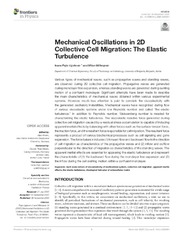Приказ основних података о документу
Mechanical Oscillations in 2D Collective Cell Migration: The Elastic Turbulence
| dc.creator | Pajić-Lijaković, Ivana | |
| dc.creator | Milivojević, Milan | |
| dc.date.accessioned | 2021-03-10T14:19:30Z | |
| dc.date.available | 2021-03-10T14:19:30Z | |
| dc.date.issued | 2020 | |
| dc.identifier.issn | 2296-424X | |
| dc.identifier.uri | http://TechnoRep.tmf.bg.ac.rs/handle/123456789/4448 | |
| dc.description.abstract | Various types of mechanical waves, such as propagative waves and standing waves, are observed during 2D collective cell migration. Propagative waves are generated during monolayer free expansion, whereas standing waves are generated during swirling motion of a confluent monolayer. Significant attempts have been made to describe the main characteristics of mechanical waves obtained within various experimental systems. However, much less attention is paid to correlate the viscoelasticity with the generated oscillatory instabilities. Mechanical waves have recognized during flow of various viscoelastic systems under low Reynolds number and called "the elastic turbulence." In addition to Reynolds number, Weissenberg number is needed for characterizing the elastic turbulence. The viscoelastic resistive force generated during collective cell migration caused by a residual stress accumulation is capable of inducing apparent inertial effects by balancing with other forces such as the surface tension force, the traction force, and the resultant force responsible for cell migration. The resultant force represents a product of various biochemical processes such as cell signaling and gene expression. The force balance induces (1) forward flow and backward flow in the direction of cell migration as characteristics of the propagative waves and (2) inflow and outflow perpendicular to the direction of migration as characteristics of the standing waves. The apparent inertial effects are essential for appearing the elastic turbulence and represent the characteristic of (1) the backward flow during the monolayer free expansion and (2) the inflow during the cell swirling motion within a confluent monolayer. | en |
| dc.publisher | Frontiers Media Sa, Lausanne | |
| dc.relation | info:eu-repo/grantAgreement/MESTD/inst-2020/200135/RS// | |
| dc.rights | openAccess | |
| dc.rights.uri | https://creativecommons.org/licenses/by/4.0/ | |
| dc.source | Frontiers in Physics | |
| dc.subject | multi scale nature of viscoelasticity of multicellular system | en |
| dc.subject | collective cell migration | en |
| dc.subject | apparent inertia effects | en |
| dc.subject | the elastic turbulence | en |
| dc.subject | rheological behavior of extracellular matrix | en |
| dc.title | Mechanical Oscillations in 2D Collective Cell Migration: The Elastic Turbulence | en |
| dc.type | article | |
| dc.rights.license | BY | |
| dc.citation.other | 8: - | |
| dc.citation.rank | M22 | |
| dc.citation.volume | 8 | |
| dc.identifier.doi | 10.3389/fphy.2020.585681 | |
| dc.identifier.fulltext | http://TechnoRep.tmf.bg.ac.rs/bitstream/id/2046/4445.pdf | |
| dc.identifier.scopus | 2-s2.0-85096402159 | |
| dc.identifier.wos | 000591196100001 | |
| dc.type.version | publishedVersion |

